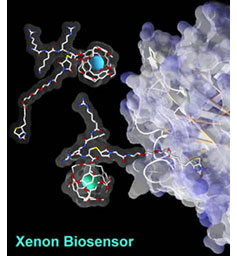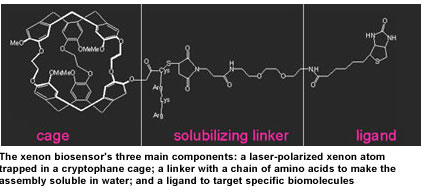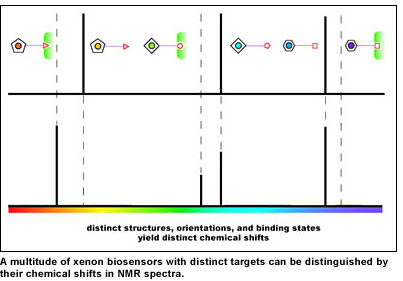BERKELEY, Calif., Oct. 9 -- A team led by Alexander Pines and David Wemmer, working with colleagues at the Scripps Research Institute in La Jolla, have developed a sensitive and versatile new biological sensor based on nuclear magnetic resonance (NMR). Pines and Wemmer are members of Berkeley Lab's Materials Sciences Division and Physical Biosciences Div., respectively; both are professors of chemistry at the University of California at Berkeley.

The secret of the new biosensor lies in confining laser-polarized xenon atoms inside specially modified molecular cages. By using optically pumped xenon, the caged-xenon sensor promises to produce much "brighter" signals from chemical targets in living organisms. Most current biosensors use fluorescence, but only a few colors can be used in parallel before the spectra from different biological molecules overlap and obscure one another. The caged-xenon NMR sensor, however, can be "multiplexed" to a high degree, to detect many distinct analytical targets simultaneously.
Several components work together in building different versions of the versatile biosensor. In all versions, a laser-polarized xenon atom is trapped in a hollow molecule called a cryptophane. A linker, containing a short chain of amino acids that makes the cage water soluble, connects it to a ligand, which can be selected to recognize a specific target of interest. In another scheme, the linker can connect to a protein whose binding sites match specific biomolecules to be detected.
To design and craft the "supramolecular cage" assembly, NMR experts from the Pines laboratory joined with molecular biologists in Wemmer's group. Expert knowledge of synthetic chemistry came from the laboratory of Peter Schultz, formerly of Berkeley Lab and UC Berkeley, now director of the Genomics Institute of the Novartis Research Foundation and professor of chemistry at the Scripps Research Institute in La Jolla, Calif.
NMR detects atoms like xenon whose nuclei have a magnetic moment because there is a slight excess of spin "up" nuclei over spin "down" nuclei. The excess of up versus down spins is normally only about one in 100,000, but optically-pumped xenon vastly increases signal strength by increasing the proportion of spin-up nuclei, producing a population of xenon atoms with one in five -- some 20 percent or more -- of their nuclei in the up state.
NMR fingerprints atoms of specific chemical species by detecting their characteristic emission frequencies after they have been perturbed by radio waves. Signals from a given type of nucleus vary according to its chemical environment; bonding in different chemical compounds, for example, causes distinctive "chemical shifts" in the signal from a single kind of atom, which show up as separate peaks in an NMR spectrum.

The new biosensor is comprised of an arsenal of subtly distinct molecules with different kinds of cryptophane cages and different kinds of ligands or proteins, plus different orientations of attached amino acids and tethers. Because each has a different chemical shift in the NMR spectrum, different binding events can be simultaneously identified and are made easily detectable because of polarized xenon's "brightness."
However, "xenon is a noble gas and doesn't react, so it takes ingenuity to use it," Wemmer said. The Pines lab has pioneered laser-polarized xenon NMR in a host of applications, from materials sciences to medical magnetic resonance imaging (MRI). Wemmer's own group studies protein structure and function with NMR.
Some proteins have binding sites that can accept xenon in certain conformations; Wemmer's graduate student Seth Rubin, together with Spence, postdoctoral fellow Ivan Dimitrov, and graduate student Janette Ruiz of the Pines lab, had studied weak interactions of free xenon with proteins in solution.
"In some cases, the chemical shifts were larger than expected," says Wemmer, which raised the obvious possibility that xenon NMR could be used to study protein's interactions. One obstacle: "Most proteins don't have a xenon pocket."
To meet this challenge, Pines, Wemmer and their coworkers came up with the idea of using xenon in cages to bind to molecular targets. Wemmer calls cryptophanes -- invented in the 1980s and not easy to synthesize "but in the literature" -- an "artificial pocket" for the xenon. But how to get the artificial pocket to attach to a target like a protein?
"A classic case of protein binding is the biotin-avidin reaction," Wemmer says. Avidin is a protein found in egg whites that binds strongly to biotin, a B vitamin. "The avidin molecule is like a big magnet that grabs the smaller biotin." Biotin ligands with chemical tethers attached are sold commercially; in theory, all that had to be done was attach the caged xenon to the other end of the tether.
With the major components of the system in place, at least on paper, and calculations indicating that the sensitivity of the new biosensor should be excellent, it remained to build the system as designed -- not an easy task.
The biotin-avidin reaction seemed an excellent testbed for the new sensor. Convinced of its potential, Peter Schultz and his coworkers, postdoctoral fellows Shao Qin Yao and Feng Tian, contributed critical techniques and suggestions, including the incorporation of a short peptide chain of four amino acids to render the insoluble cryptophane cage soluble in water.
To demonstrate the technique, the modified cryptophanes were dissolved in water, and laser-polarized xenon was added. The cryptophanes quickly bound xenon atoms, filling essentially all the cages.
NMR spectra were first taken with no avidin present; the spectra showed a peak signalling xenon's distinctive chemical environment inside the modified, water-soluble cryptophane cage -- a peak easily distinguished from the distant peak of free xenon dissolved in water.
When avidin from egg whites was added to the mix, another distinctive peak appeared in the spectrum. To check that this was a signal of biotin-avidin binding, a spectrum was taken of a mixture that contained avidin already saturated with biotin. Under these conditions the peak wasn't present -- indicating that when present it unambiguously identified caged xenon bound by biotin ligands to avidin molecules.
"Compared to other good biosensors like fluorescence technologies, xenon NMR biosensors have two great advantages," says Spence. "With fluorescence, you have to excite the probes with a laser, so you can't use them in complex living organisms. But NMR, like its relative MRI, isn't invasive -- the radio waves used travel easily through cells and tissue, so analysis can be done in vivo. And the xenon NMR biosensor can also be multiplexed."
The latter possibility arises not only by choosing ligands which can bind to different proteins -- or attaching proteins to the xenon cage which seek out small target molecules instead of other proteins -- but also because the cryptophane cages themselves can take different shapes or orientations (chirality), each with a distinct chemical shift.

"This means highly resolved, separate peaks, much easier to read than comparable spectra from fluorescence, which tend to overlap," Spence says.
Still other distinguishable molecular structures result from the orientation of the amino-acid chains and even the orientation of individual atoms in the tether. "We are only changing directions of atoms, not the atoms themselves, yet we can build a whole library of chemical shifts indicating subtle changes," says Spence, comparing this wide variety of possible simultaneous indicators to the limited range of colors fluorescent biosensors can use at one time to identify different targets of interest.
Wemmer speculates on the numerous possible uses of xenon biosensors: "There are lots of times you want to know whether or not something is present in the body, like arterial plaques or cancer cells, and often you want to know to what degree something is present compared to something else. The body can generate antibodies specific to virtually any target. Maybe we can take that antibody and tie it to xenon in a cage. For any chemical species for which you can get a selective reaction, you may be able to use this method."
The technique is being tested with various "diastereomers" -- several orientations of cryptophanes combined with attached components of different orientation -- and a variety of ligands and proteins. Development is still underway and the path to further progress lies open.
"The interesting part is that this research is a hybrid that brought together a number of different techniques," says Wemmer. "Technique A was known, and technique B was under development, but when you put A and B together, you get something never done before."
For more information, visit the Alexander Pines lab at: waugh.cchem.berkeley.edu/v2/
Licensing opportunities for the xenon biosensor: www.lbl.gov/Tech-Transfer/collaboration/techs/lbnl1643.html